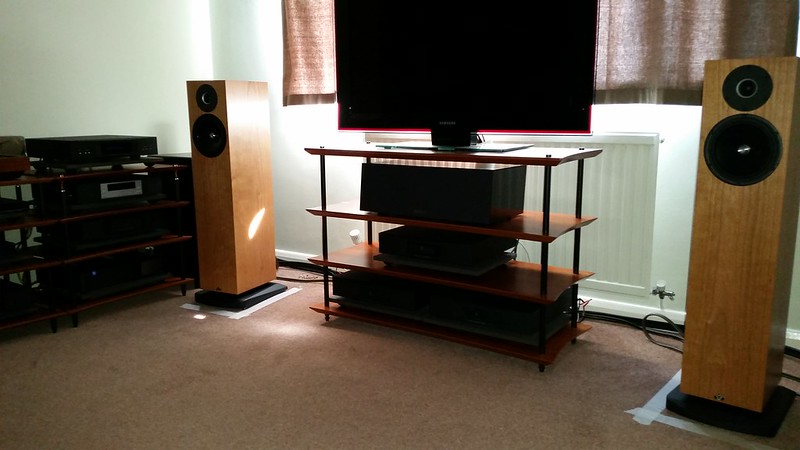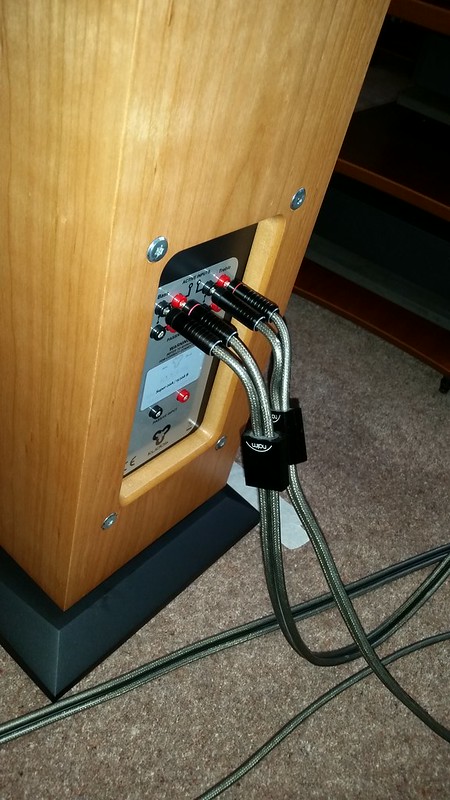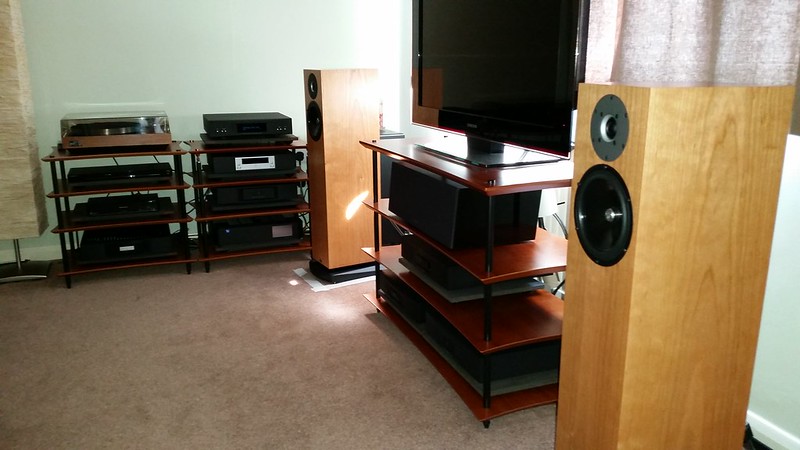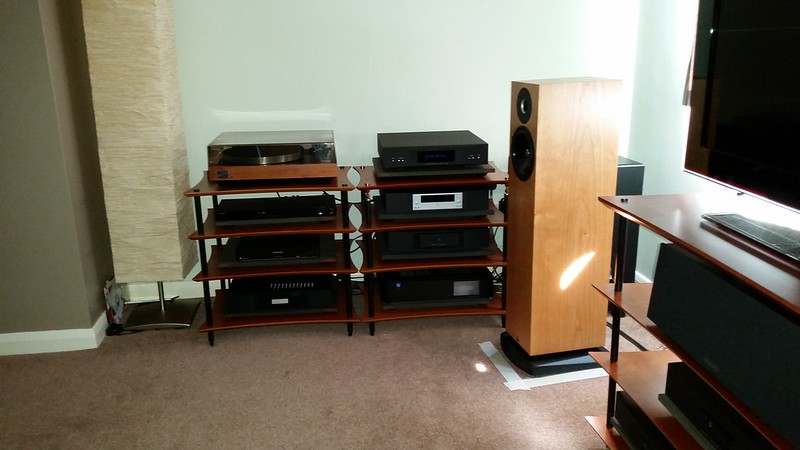There's a bit of a back story, so please bear with me.
First, I'm going to assume a working knowledge of Linn Exakt and what it can do to process the musical signal coming from a DAC, through a set of power amps and on to each driver in a loudspeaker. If you're not so sure, you can follow these links for some more information:
http://audiophilemusings.blogspot.co.uk/2016/06/linn-exakt-and-pmc-twenty26-world-first.html
https://linn.co.uk/technology/exakt
https://linn.co.uk/technology/exakt
Also, there's lots on the blog about my current system of Linn Akurate Exakt and PMC Twenty.26 which forms the basis of comparison here, so have a dig around if you need to catch up on the reference point for this review. But before the PMCs, I tried some different options, one of which was the Kudos Super 20. At the time, this was with a Linn Klimax system using a more traditional, passively driven, approach. That review is here, but to summarise on my view of the Super 20s in that system in my room:
"So its a mixed bag. I really understand why they're a good seller and why their owners enjoy them so much - I get the appeal of the etched instruments, I get the speed, I get the way they do female vocals. If I was in the market for speakers at this price point, I would say that they could be on a short list. But I need to relax into my music. I like chilled out music to wash into the room and give a warm feeling as I sit back after work and wind down. When a system doesn't let me do this, its not right for me. Others will have a different view.
As such, these aren't the right speakers for me or my room. They're different to the M140s, but they're not the right mix of abilities to justify a change to the Super 20s. I'm looking for a bigger difference, but perhaps, more of what I have, rather than a different direction."
As such, these aren't the right speakers for me or my room. They're different to the M140s, but they're not the right mix of abilities to justify a change to the Super 20s. I'm looking for a bigger difference, but perhaps, more of what I have, rather than a different direction."
So not a ringing endorsement in my system and room, but certainly something to consider in the right size room - they work well in their owner's own listening room which is somewhat smaller in volume than my own room.
Kudos Get Activated
Since then, Kudos have committed to delivering all their "upper" range speakers (at the moment, that's Super 10, Super 20, T-707 and T-808) with the ability to run with active amplification - ie, the passive crossover in the loudspeaker is by-passed, an active crossover is placed in front of the power amplifiers and each power amp channel controls just one driver each. This has been successful for T-808 with both Linn Exakt and Devialet implementations which you can read about at those links. Most recently, I had my first taste of Kudos's newly launched T-707 being partnered with Naim electronics including a SNAXO active crossover. This is a deeply impressive combination, heard at the Chester Hifi Show 2017.
A little while ago, the Super 20 (re-named 20a) has been treated to the Kudos connection panel which allows passive or active use of the speaker. Conversion from passive to active is extremely simple - just pull out 4 jumper hoops and connect your amps to the appropriate driver connections. So simple, in fact, that Kudos don't explain how this is done on their instruction sheet. Perhaps there is an expectation that the dealer is involved in most installations.
 |
| New Kudos Super 20a ready for listening |
Review Caveats
There are a couple of caveats to this review to bear in mind. First, and crucially, we had a pretty much brand new demo pair to work with. So new, the Cherry veneer was still very pale indeed - I know this darkens over time to something much deeper and richer. We estimated the speakers had about 50 hours of use on them - this is important to bear in mind as you read the review, as speakers often take a while to settle down or 'break-in' from new and their character can change a surprising amount over this time. Second, we only had a 3 hour window to work within, so there's a chance there may be more to come given more set up time - on this one, we saved a good chunk of time by going straight to the speaker position we'd found had worked best for the speakers in passive form. I think that's a very reasonable approach to take and should result in something pretty close to optimal.
Local friend R has earlier passive Super 20s in a Naim NDS/555, 282/Supercap DR and 250DR system with SuperLumina cables throughout. This lot feed a pair of the earlier Super 20s which don't permit active operation. This means there are 2 of us with experience or extensive experience of the Super 20s in this system. R's Super 20s are the ones reviewed in my previously passive Linn Klimax system. This gave the opportunity to directly compare the brand new speakers against a set with thousands of hours of use. Hence the first caveat - straight out of the box the newer pair were over bright and the bass was 'stiff' and inarticulate in comparison. To the extent that both of us found listening rather tiring. So they were left playing away to themselves, facing each other with one out of phase to reduce the amount of sound they produced. This is how we know they have at least 50 hours of music under their belts.
Set Up
So some perspective from the above in the context of a familiar system and a current (very happy) owner.
2 days later and they're set up in the Musings listening room, positioned where the passive pair had sounded best. A quick look at the brief instructions soon told us that we had to work out the active connectivity ourselves, but it is simple. Pull out the 4 connecting loops and hook up the correct speaker cable to their respective 'active treble' or 'active bass' connection. Linn Konfig was spun up on the laptop and the Exakt filters for the Super 20s were selected from the menu and installed into the Exaktbox whilst the power amps were still switched off. After confirming the Exaktbox connections against the Konfig diagram, it only took 15 minutes or so for everything to be ready to go. As is the way with active systems - care with connecting is critical. Connect a bass channel to the tweeter and you can expect a short puff of smoke, silence and a bad smell. So the bass driver is always connected first - if you accidentally send treble information to this driver its no big deal. So make sure the bass drivers are connected then listen to music at low volume and make sure the bass driver is producing bass. If its all good, then connect up the treble and listen to it very quietly to make sure its only handling treble. If all is good, on with the music...
System
Here's the system driving the Super 20a with an Exakt feed, in source to speaker order:
- 16 bit and 24 bit uncompressed FLAC files
- QNAP 251 NAS with WD Red drives
- Minimserver UPnP database
- Cat 7 ethernet cable
- Netgear GS-108T network switch with Friwo medical PSU
- Chord Anthem streaming cable
- Linn Akurate Exakt DSM streamer / Pre-amp (with power from PS Audio P5 regenerator)
- Chord C-Stream streaming cable
- Linn Akurate Exaktbox 10 DAC/processor (with power from PS Audio P5 regenerator)
- Linn "silver" analogue interconnects
- 2x Linn Akurate 4200/1 power amps (with power directly from the mains)
- 2x 3m pairs of Naim SuperLumina speaker cables
- All electronics supported by Cyrus Isoplats on Quadraspire EVO racks
Tracks used:
- Falling Out of Love - Mary Gauthier
- Six Blade Knife (24 bit from DSD) - Dire Straits
- Gula - Deadmau5
- Keith Don't Go - Nils Lofgren
- Fender Bender - Chris Jones
- Breathe You In (ft. Laura Hahn) - Ficci
- Wicked Game - London Grammar
- Walking With Elephants - Ten Walls
First Impressions
That brightness noted in R's home system was still in evidence here, making the system difficult to listen to, but bear with me as this isn't the end game here. One thing we also noticed immediately was the articulation, drive and rhythm in the bass line - although there were some room modes being driven here, leading to a touch of boom - that initial stiffness noted at first listen in R's system isn't evident in the Exakt system - either due to the different system, some benefits of the 50 hours of playing time, or perhaps a combination of both. Vocals immediately stood out as crisp and clear with tone and intonation clear in the expression of the words. So, some work to do. I think it would've been good to leave them playing for a couple more days, but time was against us.
SPACE
Turning once again to Linn Konfig, the first thing to address was the room modes which were giving a touch of boom in the room - it wasn't at all excessive, but it was there. Whilst the room measurements themselves were untouched, the position of the speakers in the room was amended to suit the positions of the Kudos boxes and the optimise button was pressed. The newer SPACE implementation - where each left / right speaker receives different settings - was evident in the profile graph - much more so than with the PMC 26s. This brought an immediate improvement to the punchiness, tunefulness and articulation of bass line. But it was a touch light so we took a couple of dB out of the notch and narrowed it significantly and that worked a treat. As usual with SPACE this opened out the mid-range and treble too - a mixed blessing.
Sometimes, its possible to tackle some vocal harshness by adding notches in space in the 65 to 74Hz range and whilst these gave some subtle benefit, it just wasn't significant. So we moved up the range and added a -1.8 then -2.0dB treble shelf which Linn allows you to add from 8kHz upwards - and this was a little helpful, but not the answer. So that was moved up to 17kHz and then we added a custom filter - a -2dB dip centred around 8.5kHz but with a very high width value which effectively gave us a 3.5kHz to 17kHz wide shelf. And that really hit the spot. Notching this down to -3dB across the same frequency range got us to the right place. Everything clicked at that point and we started to settle down into listening to the music rather than to the system and its tendancy to spotlight every single thing in the upper frequencies. This is the first caveat - it would be great to get the speakers back again soon when they've had a lot more hours of use - to see if this treble attenuation can be dropped over time as the speakers break-in.
Listening to Music
So now we had a very satisfactory sounding system, we cracked on with listening to some tracks. Bear in mind here that R has been listening to these speakers for around 3 years now and has been through a good few system upgrades during that time, so he's very familiar with their capabilities. It turns out, whilst they might be familiar, they haven't really reached their full potential in the Naim passive system. What we heard in about 90 minutes of listening with Exakt was a revelation. These speakers, whilst not carrying the same weight and authority as the PMCs (which have a somewhat larger visual and physical presence in the room), they're no longer out of their depth in my room. They go astoundingly deep from such a small box, with plenty of drive and give a bass line that, had we not already heard the PMCs, would be thought of as very good indeed - add in their relatively small dimensions and that makes them quite remarkable in this area. Tunes that needed to boogie along did so, attack is good as is the timing of the tune.
What about detail? Well, its astounding - these speakers really can resolve tiny tiny details that is beyond the capabilities of the PMCs and significantly beyond how they sound at home in the passive system. Both acoustic guitar tracks (Lofgren and Chris Jones) deliver string sounds that are crisp, clear and easy to pick out - delivering initial attack in spades and long long decays into the background. Spitty anger in Mary Gauthier's voice make you feel a bit uncomfortable and pleased that you're not the subject of her aggression. Vocals are superb - a good bit more texture, inflexion and intent than with the PMCs. Imaging is spot on too - rock solid, easy to place, 3 dimensional and a little unsettling on those tracks (such as Ficci) that use processing to give a wrap-around effect in the room.
Is there a downside? Well, its difficult to find anything to fault but I would prefer a little more subtlety in treble leading edges - R found it just to his taste, for me its still a bit sharp.
But here's the thing - throughout, we could both follow tunes and feet were tapping - and I mean throughout. On top of that, R kept giving little involuntary smiles and shaking his head in disbelief. These speakers are very much more capable than either of us really knew and Exakt with active amplification has brought that out from under the covers of passive operation.
I'll leave it with some of R's words - stunning, outstanding, and several more that I won't repeat in a public forum.
Post Script
We hope to get the speakers back again in a couple of weeks time to follow up on if they've settled in and need less treble attenuation - if this happens I'll report back here. Also, after the Super 20s left the building, the SuperLumina speaker cable stayed in the house for a little longer. Interestingly, using this cable on the treble of the PMCs reduced the gap in detail resolution by about 50%, bringing the PMCs closer to the Kudos boxes in this area. Would I swap the PMCs for a pair of Super 20s? No, but that's no reflection on the capabilities of the Super 20a, more that there is a different set of priorities from which to choose. Having lived with the superb bass performance of the PMCs, their relative lower level of detail resolution and lesser capabilities in vocal resolution are a reasonable compromise to live with. And I'd be looking for a substantial improvement if moving on - not a different compromise. Roll-on the Kudos T-606 in the summer!
Thanks to Kudos and Acoustica for the loan of the speakers.




Thanks Neil
ReplyDeleteFascinating write up as usual almost felt I was in the room listening with you both
Hi Neil. Timster from the Linn forums here. Any news on the follow-up on this test? It does sound promising. I have a thread re. these vs my 140s when going to Katalyst. Cheers.
ReplyDelete